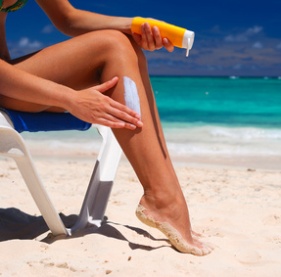
Are you curious about the causes of age spots? Age spots sometimes referred to as liver spots or solar lentigines, are most common in people over the age of 50. That’s why they are often called age spots because you get them as you age. However, people of any age can get them.
There are a lot of misconceptions out there, but we’ll tell you about what really causes age spots as well as what you can do to prevent them. We’ll also tell you about our preferred treatment for age spots, in case you have some and want to get rid of them.
Common Causes of Age Spots
Age spots are not really caused by the aging process. They are just referred to as age spots because they become more common as you age.
The spots are caused by exposure to ultraviolet (UV) light, such as sunlight. That’s why they are sometimes called solar lentigines; solar means “sun” and lentigines means “pigmented spot.” Sun lamps and tanning beds also provide exposure to UV light and can also cause age spots.
In the top layer of skin, called the epidermis, you have a pigment called melatonin. When you are exposed to the sun, your body produces more melatonin, which is why you get a suntan when you spend time in the sun. The reason this happens is that it protects the deeper layers of the skin from the potentially harmful or even cancer-causing effects of ultraviolet light. After frequent and prolonged exposure to UV light, melatonin may be produced in very large amounts and it may form the brown or black spots sometimes referred to as age spots.
Anyone can get age spots, but you are more likely to develop them if you have very fair skin (1). Of course, the more time you spend in the sun without sunscreen, the greater your likelihood of getting them, too.
By the way, age spots are not caused by any type of liver problem and have nothing to do with your liver. The reason they are sometimes called liver spots maybe because they are often brown or liver-colored.
Preventing Age Spots
Not only should you use sunscreen in the summer, but you should use it in winter, too, and on days that don’t seem very sunny. People with dark skin should also use sunscreen. If you use tanning beds at all, do so only in moderation.

Not only does limiting exposure to ultraviolet light and using sunscreen help prevent age spots, but it also helps prevent skin cancer, which is even more important. Note that age spots are not a sign of skin cancer, though, and the spots themselves are benign. You might not like the way they look, but they are not harmful to your health in any way.
Our Preferred Age Spots Remove Therapy
Even though they don’t require any medical treatment, many people prefer to remove age spots because they don’t like the way they look. Dermatologists and plastic surgeons often remove age spots with treatments like chemical peels (using chemicals to burn away the top layer of skin) or dermabrasion (sanding away the top layer of skin). Many people prefer less invasive treatments for age spots, though, not to mention less costly treatments.
That’s why our preferred age spots removal therapy is H-Age Spots Formula, a homeopathic remedy that evens out skin tone and reduces age spots gently and naturally. Unlike chemical peels and dermabrasion, it’s painless. It’s also affordable and available without a prescription. To learn more about H-Age Spots Formula and see why we like it, just follow the link.
